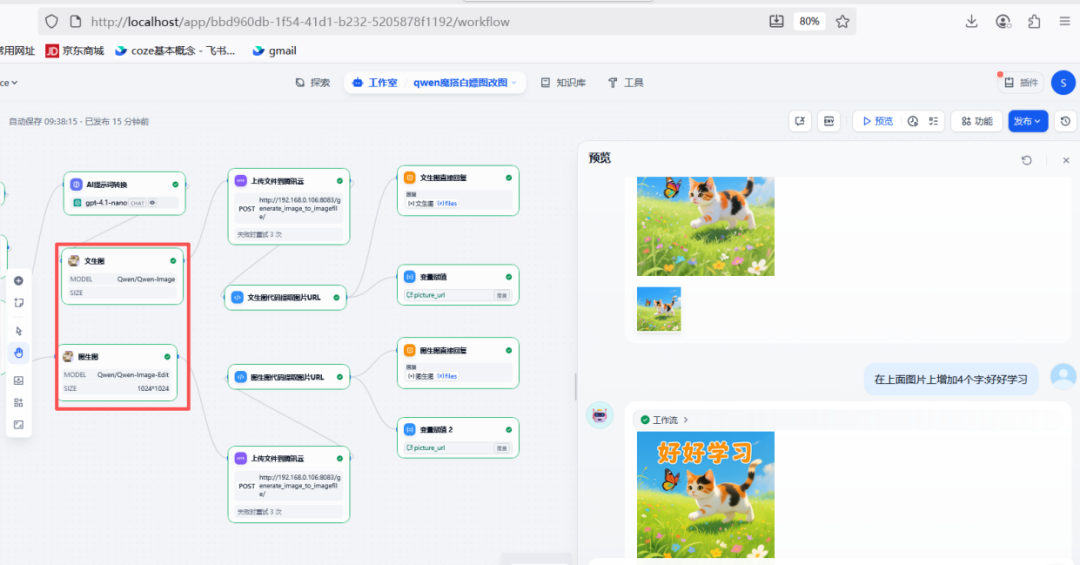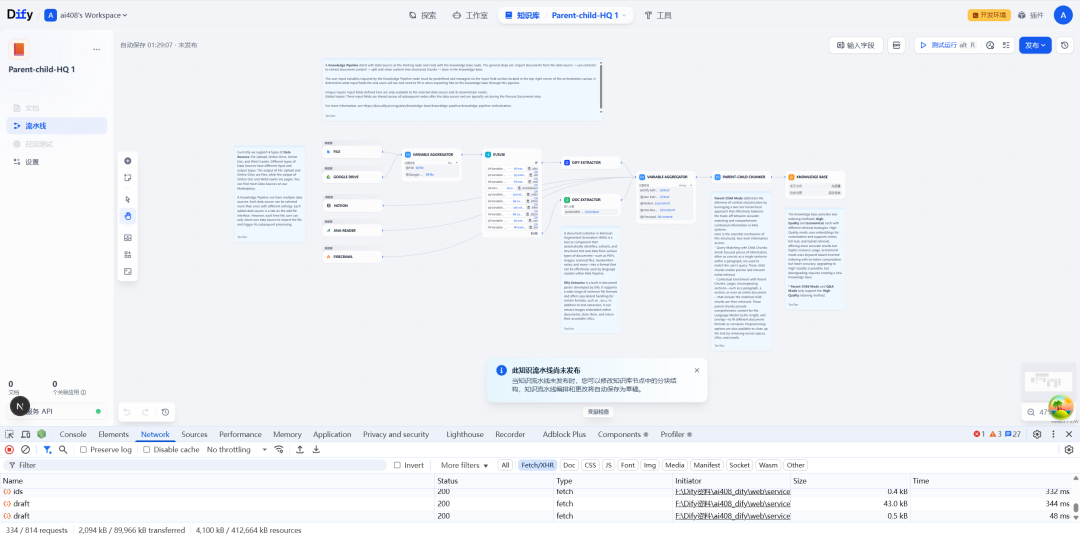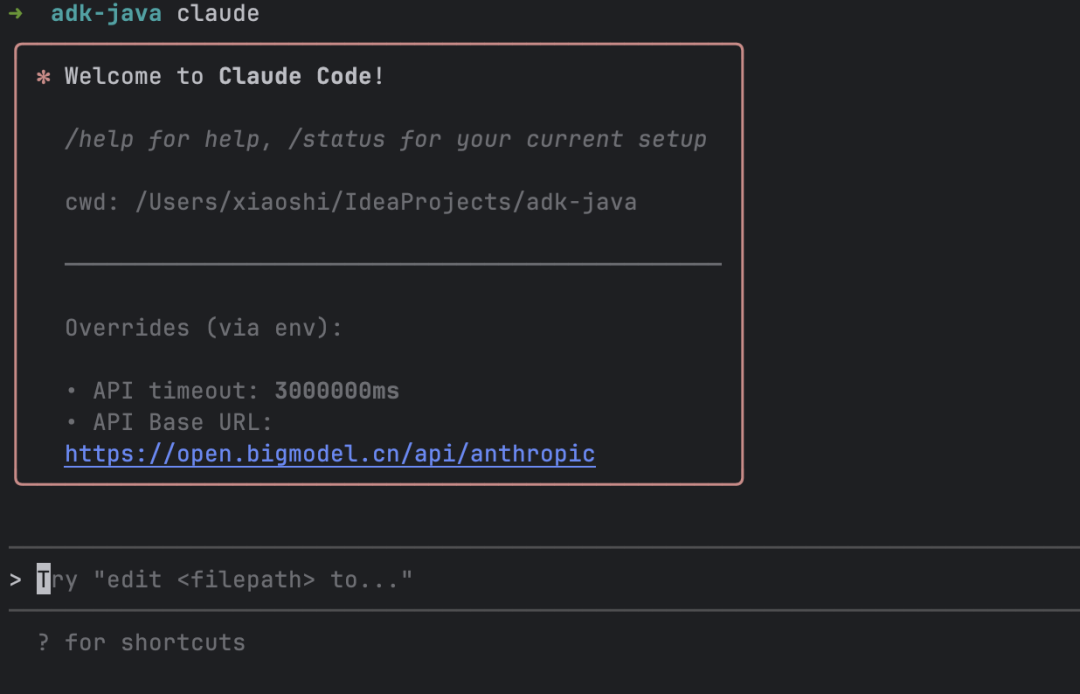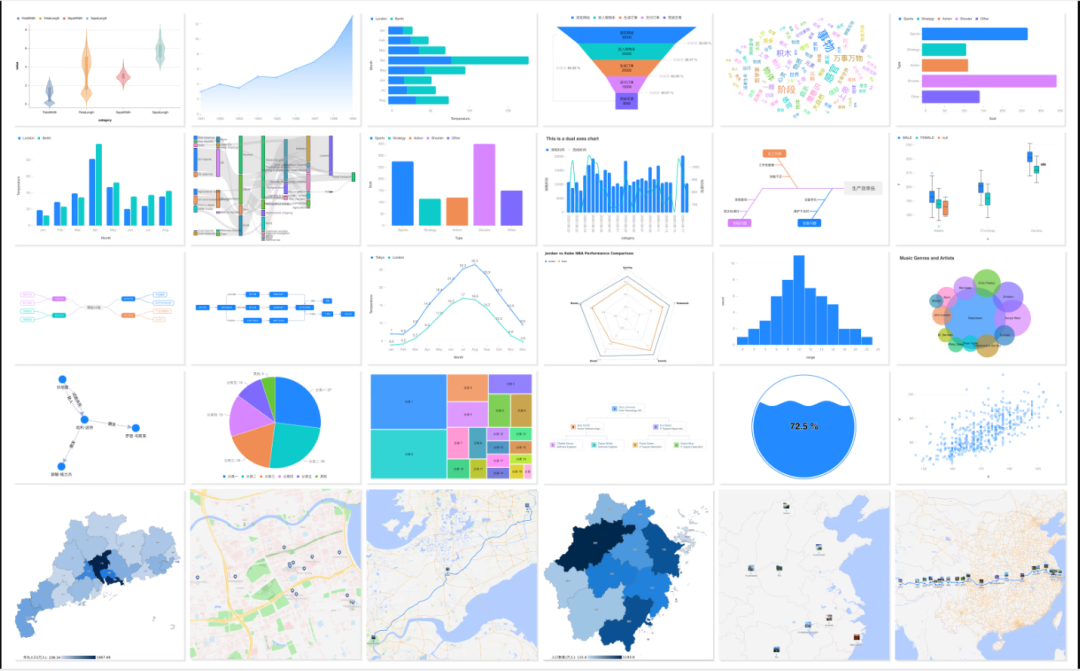Whether it's Cursor, Claude Code, or tools like Aider and RooCode, various AI programming tools are bringing their unique approach to instruction configuration (e.g., the .cursor/rules/,GEMINI.md (etc.) into the market. This diversity reflects the innovative thinking of different teams, but it also creates a "Tower of Babel" of command ecology, leading to significant fragmentation.
Developers have had to learn and maintain a large number of configuration files in proprietary formats in order to effectively guide different AI tools through their tasks. The core goal of these files is to clearly communicate complex project context, domain knowledge, and behavioral constraints to AI programming tools. However, the complexity of communication is dramatically amplified when projects are switched between tools - a carefully crafted instruction file for one tool may be completely ineffective on another. The lack of standardization not only reduces development efficiency, but also hinders the formation of a broader, interoperable AI Agent ecosystem.
Comparative Analysis of AI Programming Tool Agent Configurations
Currently, AI programming tools have evolved independently along three main directions in guiding the behavior of coding agents: structured approaches that emphasize machine readability, heuristics that focus on human readability, and "personification" approaches that abstract complex configurations into roles. There are no absolute advantages or disadvantages to these three types of approaches, but rather they reflect the different design tradeoffs of each product in realizing efficient human-machine collaboration.
| AI Programming Tools | Main configuration files/documents | specification | Core Instruction Concepts |
|---|---|---|---|
| Aider | .aider.conf.yml,CONVENTIONS.md |
YAML, Markdown | Combination of structured configurations and heuristic rules |
| Amp | settings.json(VS Code) |
JSON | Structured configuration (command whitelisting, MCP server) |
| Cursor | .cursor/rules/,.mdc |
Markdown with Metadata | Layered, context-aware heuristic rules |
| Gemini CLI | settings.json,GEMINI.md,.toml |
JSON, Markdown, TOML | Structured settings with customizable prompt templates |
| Jules | AGENTS.md, (UI Configuration) |
Markdown | Heuristic guidance, early adoptionAGENTS.md |
| Kilo Code / RooCode | custom_modes.json,.roo/rules/ |
JSON, Markdown | Personality (Modes), highly customizable |
| OpenCode | opencode.jsonc |
JSONC | Structured configuration with emphasis on permissions and security |
| Zed | .rules |
Plain Text / Markdown | Global heuristic rules at the project level |
Structured approach: emphasizing machine readability
This type of Agent relies on highly structured formats such as YAML, JSON or TOML for configuration. The advantage is the ability to precisely define operational parameters, model choices, and behavioral boundaries, providing unambiguous instructions for the operation of the Agent. However, this approach falls short when it comes to communicating subtle natural language guidance such as coding styles or architectural principles.
- Aider (
.aider.conf.yml)The YAML file is used to manage its behavior, allowing developers to specify models, configure Git commits, set up linting commands, and define test commands, reflecting a developer-centric design philosophy that ensures agent behavior conforms to project specifications through precise parameter control. - OpenCode (
opencode.jsonc)The JSONC (JSON with Comments) format provides a powerful and secure configuration system. Itsopencode.jsoncFiles can be modeled specifically for different Agents and sensitive information can be managed flexibly through variable substitution. The fine-grained permissions system is particularly impressive, allowing developers to set explicit approval requirements for critical operations such as file editing or executing shell commands (e.g."ask"maybe"allow"), giving autonomy to the Agent while returning ultimate control to the developer. - Gemini CLI (
settings.json,.toml): A hybrid structured approach is demonstrated.settings.jsonfile is used to configure the sandbox environment, MCP server and other core settings. At the same time, users can configure the core settings of the sandbox environment in the.gemini/commands/directory to create the.tomlfile to define custom commands that encapsulate complex commands into simple aliases (such as the/plan), balancing the rigor of system-level configuration with the flexibility of user-level commands.
Heuristics: prioritizing human readability
In contrast to structured approaches, heuristics prioritize the use of natural language (usually through Markdown files) to convey instructions. This approach is easier for humans to write and understand, and is particularly suited to capturing qualitative guidelines that are difficult to quantify in code, such as coding style or domain knowledge.
- Cursor (
.cursor/rules,.mdc): Its rule system is a well-established implementation in heuristics. It uses.mdc(Cursor supports nested rules, allowing specific rules to be defined in different subdirectories of a project, enabling highly contextualized AI guidance. - Aider (
CONVENTIONS.md): A lighter weight heuristic guide is provided. Developers can create aCONVENTIONS.mdfile that lists coding conventions (e.g., "prioritize the use of thehttpx"). By/readcommand loads this file into the session, and the Agent follows these conventions when it subsequently generates code, in a simple and efficient way. - Zed (
.rules): Its built-in AI Agent supports placing a.rulesfile. The contents of this file are included in every interaction with the Agent as project-level instructions, providing a quick way to inject persistence context.
Personality approach: role-based systems
A third approach is to abstract complex configurations and instruction sets into Personas. This approach dramatically simplifies the user experience by integrating system prompts, available tools, and permissions into role-based archetypes. When an AI Agent is powerful, encapsulating its capabilities into easy-to-understand roles (e.g., "architect") provides an intuitive mental model for the user.
- Kilo Code / RooCode: These two VS Code extensions are very rich in their implementation of the concept of "modes", with presets such as
Code,Architect,Debugcap (a poem)OrchestratorThere are various modes. Each mode not only contains specific system prompts, but is also given access to different tools to ensure that they are focused on specific tasks. - Aider: A simplified schema system has also been implemented to provide
code,askcap (a poem)architectThree models.codemode, the Agent modifies the code directly;askmode to participate in the discussion only;architectThe model utilizes a two-stage process, with the "architect" model making recommendations that are then translated into code by the "editor" model. - Claude Code: Its sub-agent feature, which allows the definition of Agents with specific names, descriptions, and toolsets in Markdown files, is another practice of the personification approach.
Limitations and security risks of existing mechanisms
Structured configurations such as YAML provide the precision needed for machine execution, while unstructured instructions such as Markdown are better suited to express the intent needed for human collaboration. Current tools tend to favor one side or attempt to bridge the divide with hybrid systems, but there is not yet a universal solution that elegantly unifies the two.
In the rapid evolution of Agent capabilities, security issues are often overlooked. For example, a serious security vulnerability was found in Amp Code, where an attacker could modify an Agent's settings.json configuration file to whitelist malicious commands and enable arbitrary code execution. This vulnerability reveals a critical design flaw: the scope of an Agent's operations is not effectively segregated from the administrative scope of its own configuration. A good Agent specification should not only define its privilege boundaries, but should also ensure that the specification itself is read-only for the Agent to prevent it from self-authorizing.
AGENTS.md Emergence of norms
To address these issues, the OpenAI-initiated AGENTS.md The specification was born out of a core design philosophy of simplicity and predictability. The specification aims to enable the codebase to interface with any compatible AI programming tool in a standardized way by defining a common, non-proprietary format.
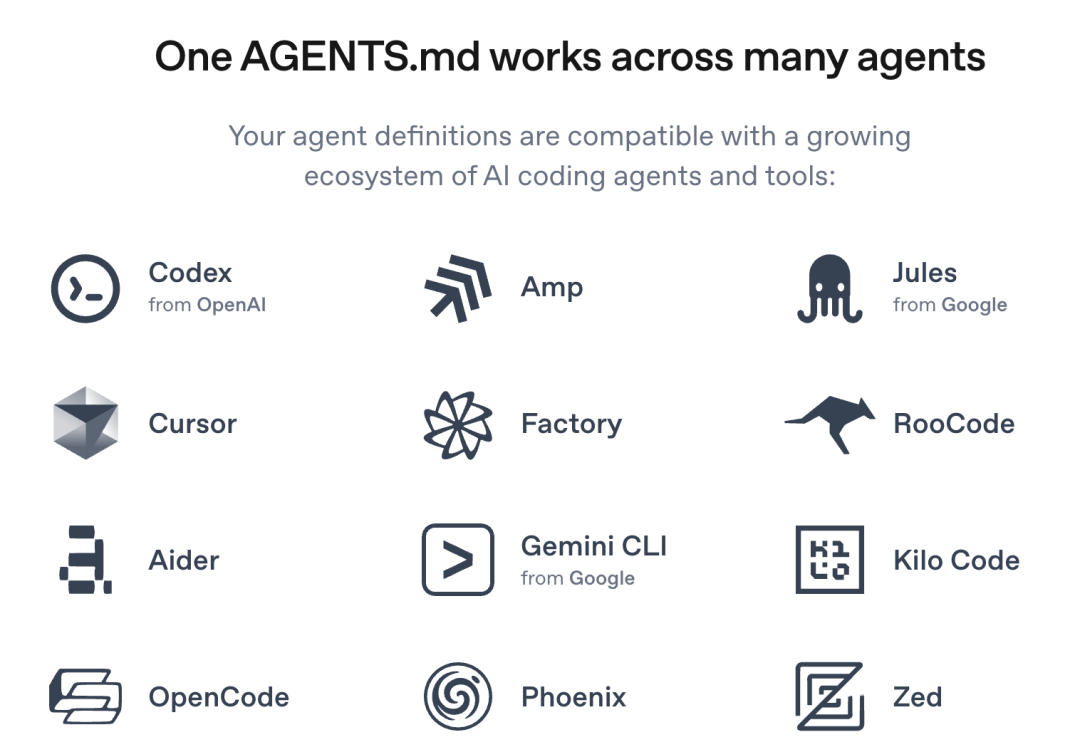
Simple and predictable
The specification's choice of the standard Markdown as its format was a deliberate decision; Markdown has a simple syntax that is easy for humans to read and write, but is also structured enough for machines to parse. By agreeing on a fixed filename AGENTS.md and placed in the project root, the protocol provides a clear and predictable root constraint for all Agents.
Best Practice Structure
(go ahead and do it) without hesitating AGENTS.md The specification itself is flexible, but the community has developed a structure of recommended best practices that typically contain the following sections:
- Project Overview & Architecture: Describe the goals, core functionality, and technology stack of the project to help Agent quickly build a macro understanding.
- Build, Test, and Development Commands: List all key script commands (e.g.
pnpm install,pnpm test) to enable the Agent to perform the validation process autonomously. - Code Style and Conventions: Clarifying the coding specifications for a project helps Agent generate code that is consistent with the style of the existing code base.
- Testing Guidelines: Provides detailed instructions for running specific tests and fixing common failures.
- Security Considerations: List the safety guidelines associated with the project.
- layered application: In order to accommodate the complexity of large monorepo
AGENTS.mdThe specification supports nesting. Subdirectories can hold additionalAGENTS.mdfile, whose directives override the generic directives of the upper directory, enabling finer-grained guidance.
AGENTS.md Essentially a set of declarative configurations. A YAML configuration file might command the Agent to execute the lint-cmd:"eslint --fix", which is an imperative command; and a AGENTS.md The file then declares an available action: "Fix formatting problems:pnpm check:fix", which requires the Agent to understand the statement when reasoning and to use it as an available tool for solving broader problems.
AGENTS.md ecosystems
The success of a standard depends on how well it is adopted by the ecosystem, and Google's Jules Agent has explicit support for automatically finding and using the repository root's AGENTS.md Documentation. Similarly, the Cursor IDE supports this specification as a simplified alternative to its project rules.
AGENTS.md A symbiotic relationship is formed with the Model Context Protocol (MCP).The MCP defines the capabilities and input/output modes of the tool. If the AGENTS.md defines the Agent's intent and knowledge ("what to do"), then the MCP then defines its capabilities and tools ("how to do it"). This standardization brings an important architectural decoupling:Separation of Agent Knowledge from Agent Core Logic. Project-specific knowledge is externalized to a version-controlled code alongside the AGENTS.md file, developers only need to maintain this one file to provide a rich project context for any compatible Agent, realizing "write once, run anywhere".
Conceptualization of a Universal Agent Specification Language (ASL)
Beyond code: building domain-agnostic specifications
AGENTS.md aims to alleviate the fragmentation of instructions in the field of AI programming, but its value goes beyond that. The core challenges of defining an AI Agent - clarifying its identity, goals, knowledge, tools, and boundaries - are pervasive across domains.
However, as Agent becomes more deeply used in non-programming domains such as marketing, design, and project management, the structure of the instructions required to handle complex tasks in these domains will go far beyond what can be expressed in the Markdown format. Therefore, a natural next step in the evolution is to design a more formal, structured, and extensible Generic Agent Specification Language (ASL)This language will be the foundation for building a cross-domain, interoperable Agent ecosystem. This language will be the foundation for building a cross-domain, interoperable Agent ecosystem.
Core Principles of ASL
ASL is designed to be AGENTS.md A superset of the idea of providing a well-structured, modular and easily extensible syntax system while retaining its high readability. One possible implementation is to use structured Markdown with YAML Frontmatter, or to design a Domain Specific Language (DSL) that can be compiled into optimized hints. The following are the core building blocks of ASL:
- Persona: Define the Agent's identity, communication style, and core responsibilities.
- Goals & Objectives: Clarify the success criteria for a task and translate the user's implicit intent into measurable explicit goals for the Agent (e.g., define the Agent's OKRs).
- Knowledge & Context: Defines the source of information for the Agent, such as a list of references to files, URLs, or APIs.
- Tools & Capabilities: Declare the actions that the Agent can perform, specifying the boundaries of its capabilities and the MCP servers to which it can connect.
- Rules & Constraints: Establish behavioral guardrails to fine-tune control of sensitive operations (e.g.
send_email: "ask") to ensure safety and compliance.
ASL Practices: Domain-Specific Realizations
To demonstrate the flexibility of ASL, the following are examples of specifications designed for three different areas of specialization.
Design Area. brand-guardian.asl
# 角色设定
persona:
identity: 品牌守护者
tone_of_voice: [权威, 精准, 富有创意]
core_function: "确保所有对外发布的素材100%符合公司的品牌规范。"
# 目标
goals:
primary_goal: "在所有线上和线下物料中,保持品牌形象的一致性。"
key_results:
- "将营销活动中的不合规素材减少 95%。"
- "素材审批周期控制在 24 小时以内。"
definition_of_done: "素材正确使用了官方Logo、字体、调色板和图像,即可视为合规。"
# 知识库
knowledge:
sources:
- "@./brand_guidelines_v4.pdf"
- "@./logo_assets_v3/"
initial_instructions: |
1. 对照知识库中的参考资料,分析待审素材。
2. 检查Logo、配色和字体是否合规。
3. 如果合规,则批准。如果不合规,提供具体的修改建议。
# 工具
tools:
enabled_tools: [file_read, image_analysis, color_palette_checker, pdf_parser]
# 规则
rules:
must_not_do:
- "禁止批准任何使用了已弃用颜色代码 #FF00FF 的素材。"
- "禁止提出修改品牌规范的建议。"
permissions:
approve_asset: "allow"
reject_with_feedback: "allow"
suggest_logo_redesign: "ask"
Market area. growth-hacker.asl
# 角色设定
persona:
identity: 增长黑客
tone_of_voice: [数据驱动, 大胆, 简洁]
core_function: "设计、执行并分析一系列快速实验,以驱动用户增长。"
# 目标
goals:
primary_goal: "实现新用户注册量每月5%的环比增长。"
key_results:
- "每月至少发起 4 项新的 A/B 测试。"
definition_of_done: "实验完成结果分析、归档记录,并为后续步骤给出明确建议。"
# 知识库
knowledge:
sources:
- "@https://analytics.example.com/api"
- "@./past_ab_test_results.csv"
initial_instructions: |
1. 基于最新数据提出一项新的增长实验方案。
2. 提出一个清晰的假设(例如:“将CTA按钮颜色改为绿色,点击率将提升10%”)。
3. 定义实验的目标用户和衡量指标。
# 工具
tools:
enabled_tools: [web_search, social_media_poster, ab_test_setup_tool, data_analysis, sql_query_runner]
# 规则
rules:
must_do:
- "在发起任何测试之前,必须先提出一个清晰且可被证伪的假设。"
must_not_do:
- "未经批准,禁止针对现有付费用户开展任何实验。"
permissions:
launch_experiment_under_1000: "allow"
launch_experiment_over_1000: "ask"
post_to_social_media: "ask"
Project management areas. project-owner.asl
# 角色设定
persona:
identity: 项目负责人
tone_of_voice: [有条不紊, 清晰明确, 直接]
core_function: "确保所有软件项目在规定范围内按时上线,并符合‘完成’的标准。"
# 目标
goals:
primary_goal: "在本季度结束前,成功将‘凤凰项目’部署到生产环境。"
key_results:
- "部署前完成发布清单中 98% 的检查项。"
- "发布后 24 小时内,严重级别的 Bug 报告数量为零。"
definition_of_done: "项目成功上线,系统性能稳定,且已发送上线公告。"
# 知识库
knowledge:
sources:
- "@https://jira.example.com/api"
- "@./release_checklist_template.md"
initial_instructions: |
1. 获取最新的发布清单。
2. 通过查询Jira和CI/CD系统,逐一核实清单状态。
3. 若所有事项均已完成,则执行部署。否则,立即中止并通知相关负责人。
# 工具
tools:
enabled_tools: [calendar, ticket_creator, git_tagger, deployment_trigger, slack_notifier]
# 规则
rules:
must_do:
- "在触发部署前,必须确认发布清单上的所有检查项都已完成。"
must_not_do:
- "若有任何自动化测试未通过,禁止执行部署。"
permissions:
trigger_deployment: "ask"
create_jira_ticket: "allow"
tag_git_release: "allow"
send_slack_notification: "allow"
abort_release: "allow"
The path to an interoperable Agent ecosystem
The ASL implementation is much more than just creating a better profile format. It points to a generalized "AI Workforce Operating System". In this model, organizations are able to create and manage their own workforce through .asl The document defines and assigns tasks, creating a bridge between human intent and AI execution. This harmonized specification provides a framework for enabling large-scale coordination, governance, and automated scaling.
- Agent Marketplace of Capabilities: Instead of developing their own Agent, organizations can simply use ASL to describe their requirements and select the most efficient service provider from the open market.
- Composable Agent Collaboration: Complex cross-functional workflows are possible. For example, the workflows created by
project-owner.aslDriven Agents can automatically delegate design review tasks, when needed, to a Design Review Agent powered by thebrand-guardian.aslAgent for control. - Implementable knowledge management: Core enterprise knowledge (e.g., brand guidelines, security policies) will be encoded into an executable ASL document that directly guides and constrains the behavior of all AI Agents within the enterprise, ensuring consistency in the transfer and application of knowledge.
Realizing this vision also heralds the creation of new roles such as "Agent Architects" or "AI Interaction Designers". Their role is to act as a bridge between human experts and AI executors, translating implicit business intelligence into explicitly executable specifications for machines. From AGENTS.md The evolution to ASL is an attempt to move from solving specific technical problems to building a common collaboration framework that empowers all knowledge work. Even if ASL may not be the final form, similar specifications are bound to emerge, leading us into a new era where AI Agents become reliable, controllable, and composable members of digital teams.





